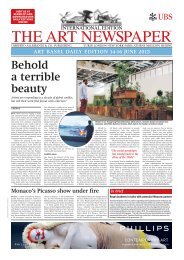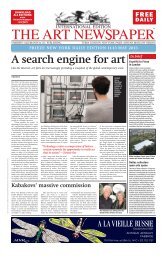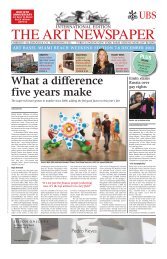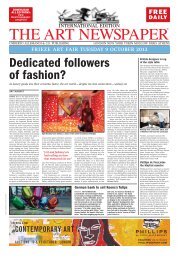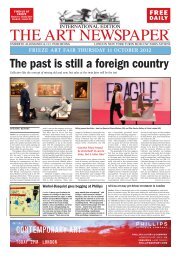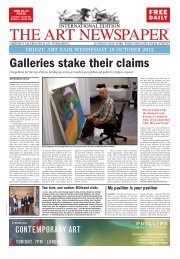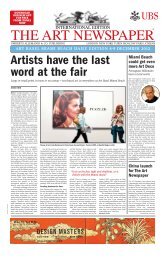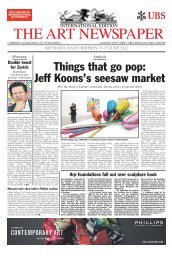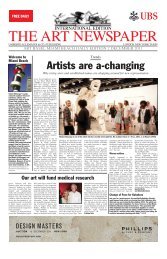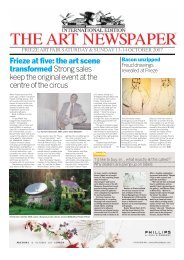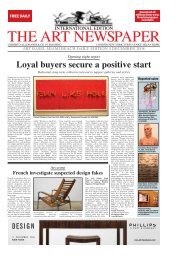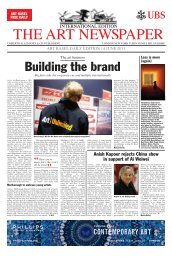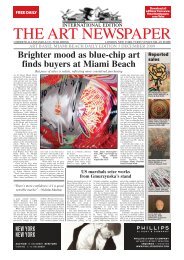BIENNALE GUIDE 2011 - The Art Newspaper
BIENNALE GUIDE 2011 - The Art Newspaper
BIENNALE GUIDE 2011 - The Art Newspaper
You also want an ePaper? Increase the reach of your titles
YUMPU automatically turns print PDFs into web optimized ePapers that Google loves.
GIARDINI<br />
● NATIONAL PARTICIPATIONS ● COLLATERAL EVENTS ● OTHER EVENTS ● CLASSICS ● FOOD & DRINK ★HIGHLIGHTS<br />
Russia: Collective Actions<br />
Moscow conceptualist in the<br />
Soviet Union in the 1970s,<br />
brings with him Collective<br />
Actions, with whom he has<br />
regularly collaborated over<br />
the past 35 years. <strong>The</strong> group’s<br />
performances, which they<br />
call Trips to the Countryside,<br />
are usually absurd, like<br />
pulling a seven-kilometre<br />
length of rope through a<br />
forest to no apparent end.<br />
www.ruspavilion.ru<br />
22 Serbia<br />
National pavilion, Giardini<br />
Exhibition: Light and<br />
Darkness of the Symbols<br />
<strong>Art</strong>ist: Todosijevic<br />
Dragoljub Rasa<br />
● A tripartite installation<br />
from the Belgrade-based<br />
conceptualist. One part<br />
features his “journal”: objects<br />
produced over a long period<br />
as experiments with ideas or<br />
materials. <strong>The</strong> second shows<br />
installations he has created<br />
in recent years, including 50<br />
teapots filled with cement,<br />
while the third is a potted<br />
history of his career.<br />
www.pavilionserbia.org<br />
23 Spain<br />
National pavilion, Giardini<br />
Exhibition: <strong>The</strong> Inadequate<br />
<strong>Art</strong>ist: Dora García<br />
● Uneasy at being the<br />
official Spanish artist, García<br />
presents <strong>The</strong> Inadequate, a<br />
© THE ARTISTS<br />
biennale-long performance<br />
piece. A “backstage” area<br />
contains vitrines and tables<br />
with props relating to writers<br />
such as James Joyce and<br />
Robert Walser, which García<br />
and various collaborators<br />
will use in performances on<br />
a central stage.<br />
http://theinadequate.net<br />
24 Sweden ★<br />
National pavilion, Giardini<br />
Exhibition: Borderless Bastards<br />
<strong>Art</strong>ist: Fia Backström<br />
Exhibition: Windows, Trees<br />
and Inbetween<br />
<strong>Art</strong>ist: Andreas Eriksson<br />
● Two explorations of the<br />
pavilion’s Giardini context.<br />
Backström looks at ideas of<br />
nationhood, working with<br />
other artists appearing for<br />
their countries to create<br />
representative figurative<br />
sculptures. Eriksson reflects<br />
on the parkland setting with<br />
paintings of trees and<br />
sculptures of birds that died<br />
by crashing into the Nordic<br />
pavilion’s glass walls.<br />
25 Switzerland ★<br />
National pavilion, Giardini<br />
Exhibition: Crystal of Resistance<br />
<strong>Art</strong>ist: Thomas Hirschhorn<br />
● In a long and eccentric<br />
outpouring describing this<br />
installation, Hirschhorn<br />
writes that he wants it to be<br />
“an indestructible and<br />
earthly dwelling of the gods”<br />
which recalls, among other<br />
things, a B-movie film set, a<br />
crystal meth lab and “a<br />
cheaply decorated provincial<br />
disco”. Love, philosophy,<br />
politics and aesthetics are<br />
the grand themes.<br />
www.crystalofresistance.com<br />
26 Thailand<br />
Paradiso Gallerie, Giardini<br />
della Biennale, Castello 1260<br />
Exhibition: Paradiso di Navin<br />
<strong>Art</strong>ist: Navin Rawanchaikul<br />
● Though not usually a<br />
Giardini pavilion, this year<br />
the café at the Giardini’s<br />
entrance houses the latest in<br />
the Thai artist’s Navinland<br />
productions. With the artist<br />
always at the centre of the<br />
proceedings, Rawanchaikul’s<br />
colourful oeuvre takes a<br />
tongue-in-cheek approach to<br />
his personal history.<br />
27 United Kingdom ★<br />
National pavilion, Giardini<br />
<strong>Art</strong>ist: Mike Nelson<br />
● Nelson was holed<br />
up in the pavilion<br />
for three months in<br />
preparation for his<br />
latest installation. As<br />
he proved in a lauded<br />
2001 work on the Giudecca,<br />
Venice is the perfect location<br />
for his networks of fantastical<br />
rooms, creating atmospheric<br />
labyrinthine narratives from<br />
his quirky historical musings.<br />
http://venicebiennale.<br />
britishcouncil.org<br />
28 United States<br />
of America ★<br />
National pavilion, Giardini<br />
Exhibition: Gloria<br />
<strong>Art</strong>ists: Jennifer Allora and<br />
Guillermo Calzadilla<br />
USA: Allora & Calzadilla<br />
6<br />
THE ART NEWSPAPER VENICE <strong>GUIDE</strong> <strong>2011</strong><br />
All<br />
exhibitions<br />
run 4 Jun -<br />
27 Nov <strong>2011</strong><br />
unless stated<br />
otherwise<br />
© THE ARTISTS<br />
● <strong>The</strong> Cuban-American duo<br />
reinforce their neo-surrealist<br />
credentials in a wry look at<br />
military, sporting and artistic<br />
glory. Gymnasts and athletes<br />
will perform routines on<br />
wooden versions of the latest<br />
in business-class airline seats,<br />
while an overturned tank<br />
becomes a treadmill outside.<br />
A satirical highlight.<br />
29 Uruguay<br />
National pavilion, Giardini<br />
Exhibition: Un Lugar Común/<br />
A Common Ground<br />
<strong>Art</strong>ists: Alejandro Cesarco,<br />
Magela Ferrero<br />
● Two Montevidean artists:<br />
Ferrero has painted<br />
and written over<br />
photographs she<br />
has taken, a process<br />
she likens to writing<br />
a map of what she<br />
sees. Cesarco’s very<br />
different oeuvre leaps<br />
between disparate media<br />
according to each individual<br />
concept, but much of his<br />
work is concerned with<br />
language and translation.<br />
www.labiennaleuruguay. gub.uy<br />
30 Venezuela<br />
National pavilion, Giardini<br />
Exhibition: Spaces<br />
<strong>Art</strong>ists: Francisco Bassim,<br />
Clemencia Labin, Yoshi<br />
● Post-pop art dominates<br />
the Venezuelan pavilion:<br />
Bassim reworks devotional<br />
images and the old masters<br />
in a lurid cartoonish style<br />
and Labina creates soft<br />
sculptures from vividly<br />
coloured and patterned<br />
materials. Yoshi’s origami<br />
experiments offer a subtle<br />
and intricate counterpoint.<br />
7<br />
THE ART NEWSPAPER VENICE <strong>GUIDE</strong> <strong>2011</strong><br />
GIARDINI<br />
● NATIONAL PARTICIPATIONS ● COLLATERAL EVENTS ● OTHER EVENTS ● CLASSICS ● FOOD & DRINK ★HIGHLIGHTS<br />
ILLUMInazioni: shedding a little light<br />
A look at Bice Curiger (left) and her central biennale show, ILLUMInazioni/<br />
ILLUMInations, whose bilingual title plays on nationhood, light, and more<br />
ice Curiger was by no<br />
means an obvious choice B as artistic director of the<br />
Venice Biennale: she is a big<br />
player, but hardly the kind of<br />
“supercurator” more often tasked<br />
with the biennale’s central show.<br />
Importantly, this is her first<br />
biennial exhibition anywhere.<br />
● <strong>The</strong>re have been two discrete<br />
strands to her career so far: her<br />
editing of the influential Parkett<br />
magazine, and subsequent role<br />
as editor-in-chief of Tate Etc, the<br />
in-house magazine of the Tate<br />
family of galleries; and her role as<br />
curator at the Kunsthaus Zurich. In<br />
both, she has developed a<br />
reputation for a serious approach<br />
with a dash of quirkiness.<br />
● In many ways, Curiger’s<br />
Kunsthaus Zurich exhibitions<br />
prefigure her Venice show: they<br />
display strong commitment to<br />
central European artists, like<br />
Sigmar Polke, Fischli and Weiss<br />
and Katharina Fritsch (all in<br />
ILLUMInazioni), and over half the<br />
artists she has selected for<br />
Venice are European.<br />
● She has also shown a talent<br />
for original, ambitious themed<br />
exhibitions, like “<strong>The</strong> Expanded<br />
Eye” (2006), looking at vision<br />
and perception in recent art, and<br />
“Hypermental” (2001), exploring<br />
the legacy of aspects of surrealism.<br />
● Eighty-three artists feature in<br />
the show, and more than threequarters<br />
come from Europe or the<br />
US. Alongside weighty lynchpins<br />
of the European scene such as<br />
Rosemarie Trockel and Franz<br />
West, there is a deliberate<br />
emphasis on relatively young<br />
artists, among them wry British<br />
conceptualist Ryan Gander and<br />
anarchic Swedish multimedia<br />
artist Klara Lidén.<br />
● A catchy and translatable title<br />
is an essential part of any Venice<br />
Biennale, and with ILLUMInazioni,<br />
Curiger provides a bilingual<br />
punning name for her exhibition,<br />
containing its two key themes:<br />
light and national identity.<br />
● Curiger conjures a wealth of<br />
associations and meanings in<br />
explaining her themes. On the<br />
one hand, she sees illumination<br />
as a key role of the Biennale—it<br />
spotlights new developments in<br />
contemporary art. It is also<br />
central to the role of art itself: its<br />
capacity to illuminate thought.<br />
● <strong>The</strong>n, there are a number of<br />
specific cultural references: the<br />
Age of Enlightenment; the poetic<br />
Illuminations of Rimbaud; the<br />
Profane Illuminations of<br />
surrealism as seen by Walter<br />
Benjamin; medieval illuminated<br />
manuscripts; and illuminationism,<br />
a school of Persian philosophy<br />
● Light is also key to the show’s<br />
most novel idea: the inclusion of<br />
three paintings by Venetian master<br />
Tintoretto, who Curiger admires<br />
for his “febrile, ecstatic lighting<br />
and a near reckless approach to<br />
composition that overturns the<br />
well-defined, classical order of the<br />
Renaissance”. He is thus an<br />
emblem for contemporary artists.<br />
● <strong>The</strong> nazioni part of the title is<br />
explored through artists’ interest<br />
in identity and heritage. Curiger<br />
sees them as migrants through<br />
culture, who use art to experiment<br />
with new forms of community.<br />
● To emphasise the art world’s<br />
elastic approach to identity, and<br />
subvert the national pavilions,<br />
Curiger has asked Oscar Tuazon,<br />
Franz West, Song Dong and<br />
Monika Sosnowska to create<br />
“parapavilions” which house<br />
work by artists from different<br />
nations. Chinese artist Song’s<br />
parapavilion features Parisian Yto<br />
Barrada, while Austrian West’s<br />
structure houses a slide projection<br />
by Indian Dayanita Singh.<br />
● Ever the art magazine editor,<br />
Curiger has sent five arch and<br />
tricky questions to each artist,<br />
including those in the national<br />
pavilions. <strong>The</strong>se include: “Is the art<br />
community a nation?” and “How<br />
many nations are inside you?” <strong>The</strong><br />
answers appear in the catalogue.



